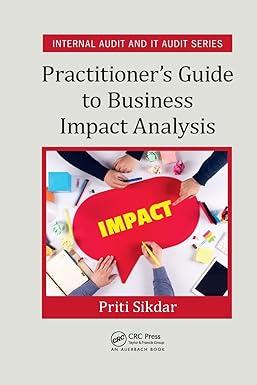Question
Tax Research Exercise Five assorted tax research problems follow below (each problem is worth up to seven (7) points thirty (35) points possible for the
Tax Research Exercise
Five assorted tax research problems follow below (each problem is worth up to seven (7) points thirty (35) points possible for the entire exercise). You should present (on regular copy/printer paper and an electronic file see instructions) your answers to these problems using the following format:
Issue: Restate the primary issue(s) in the problem (you can copy and paste from the facts provided below) and if appropriate, list any additional issue(s) you determined were relevant from your research.
Conclusion: Answer the basic issue or issues in concise yet meaningful terms. These should be plain-language statements not technical jargon.
Arguments and Authorities: Explain the basis for your conclusions above. Include appropriate technical citations with related analysis (e.g. IRC 172 provides that a business may carry forward a Net Operating Loss generated before 2018 for twenty years or In Gregory v. Helvering, 293 U.S. 465, the United States Supreme Court held that there must be a valid business purpose.). In general, one or two explanatory paragraphs should be sufficient, but you can be a bit longer if you deem it necessary.
Note: Unless otherwise indicated in the case facts, all research should focus on the tax law and related rules and regulations in effect as of December 31, 2018 (current law). In other words, since the default in most cases in CCH Cheetah and RIA Checkpoint is to current law and rules, drilling-down for older materials is not generally appropriate or needed.
2) Stephen Foster is a licensed scuba diver who lives near Jacksonville, Florida. He is employed full-time as the manager of a local resort. Five years ago, he had been employed as a professional diver for a commercial salvage company. While working for the salvage company he became interested in marine archaeology and treasure hunting. Until last year, Stephen offered diving lessons on weekends and trained individuals in the sport of treasure hunting under the registered trade name of Stephens Aquatics Academy (Stephens DBA). Three of the diving students he taught subsequently found shipwrecks. Stephen generally did not engage in recreational diving. Last year, Stephen began a treasure hunting business he named Treasure Seekers Company (an LLC Stephen treated as a Schedule C business for income tax purposes). He opened a separate bank account in the name of the company. He bought a boat specifically designed for treasure hunting and did extensive research on potential locations of shipwrecks. Stephen actually located several shipwrecks, but none had any substantial value. Stephen did retrieve several artifacts from these wrecks, but has not sold any yet. Although these artifacts may have some historical significance, they may have a limited marketability. Thus, Stephen has not yet generated any gross income from his treasure hunting activities. Other than retaining check stubs and receipts for his expenses and an encoded log, Stephen avoided maintaining significant formal records for Treasure Seekers Company. In fact, Stephen maintains as few written records as possible because he fears for his safety. Stephen is aware that other treasure hunters have been attacked and had finds stolen. He took steps to keep his boat and equipment from public view and took precautionary measures to maintain the secrecy of his search areas. Stephen incurred about $12,000 of expenses relating to his treasure-hunting activities last year
Primary Issue: Is Stephen engaged in an active trade or business that will allow him to deduct the expenses of his treasure hunting activities? On the other hand, is it more likely the IRS will assert the treasure hunting activities are merely a hobby and disallow deductions for the expenses? Hint: Start with IRC 162 and 183 and the related pertinent Treasury regulations. Also, review Randy R. Reed, III, T.C. Memo 1988-470, 56 TCM. 363.
Step by Step Solution
There are 3 Steps involved in it
Step: 1

Get Instant Access to Expert-Tailored Solutions
See step-by-step solutions with expert insights and AI powered tools for academic success
Step: 2

Step: 3

Ace Your Homework with AI
Get the answers you need in no time with our AI-driven, step-by-step assistance
Get Started


